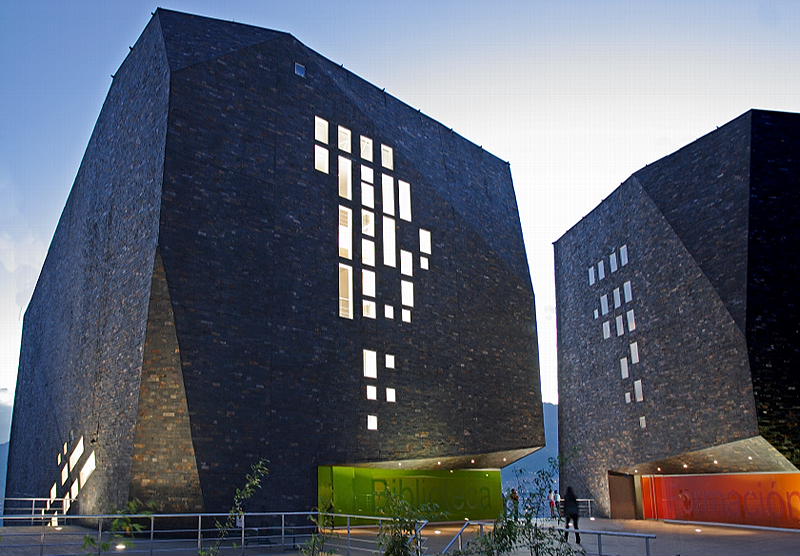Envisioned as an architectural symbol of change in Medellin’s once violence-laden eastern hills, the Biblioteca de España is already facing a number of structural issues.
Designed by Colombian architect Giancarlo Mazzanti in 2005, the library was built in 2007 and became a stand-out feature of the cityscape and its Santo Domingo community, part of an urban development project that saw the construction of the city’s now iconic cable-car system.
The mostly concrete structure is covered in 30% oxidized black slate, giving the three buildings that comprise the library the appearance of giant stones protruding from the hillside. Between the library itself, the community center and cultural center, the buildings cover some 12,227 square-feet and can be seen from across the city.
Why are they covered up?
The three seven-year-old buildings have been covered up since April 2013 due to structural problems. Reportedly, construction did not adhere to architectural plans. Further problems arose with landslides in April and August of 2013, causing local governing bodies to cover the three buildings in black material while repairs are made.
Studies done by the Administrative Department of Disaster Risk Management (DAGRD), the Urban Development Enterprise (EDU) have stated that work will have to be done in order to make the building safe, plans that potentially include removing all of the top level of slate tiles to amend structural weaknesses.
According to engineer Jospeg Farbiarz, “The facade does not meet the statutory requirements to withstand wind loads,” and is not fully waterproof, reported El Colombiano newspaper.
When Colombia Reports spoke to the librarians and those working within the shrouded library, it learned that the original time-frame for the repairs was six months. One year later, and they still haven’t heard what the plans are, much less seen any significant progress.
Changing a community
The Bilioteca de España, so named because of funding from the Spanish government, contains libraries for all ages, as well as a computer suite with free internet access and a day care center for users with kids. This new access to materials has created opportunities for many residents of the hillside’s poorer communities by providing not only the means to study but a quiet space to do so.
The library was built after a metro-cable connecting Santo Domingo with downtown Medellin was finished, making the previously isolated district more accessible and creating possibilities for other development projects, such as the library, going forward.
Medellin’s so-called “library parks” were the initiative of ex-Mayor Sergio Fajardo, who came to power on a social platform that included the construction of libraries in various high-risk areas for violence across the city.
Between 2005 and 2008, five library parks were built, with an additional five built between 2009 and 2011. As a result, an estimated 784,000 people received access to city services.
Santo Domingo was one of the communities most affected by the violence which pervaded Medellin during the 1980s and 90s, when drug trafficking and urban guerrilla activity gripped much of the city. The metrocable and library, part of a strategy oriented toward increasing mobility in previously unaccessible areas and providing services to troubled communities, were key factors in the Urban Land Insitute’s decision to award the 2013 Most Innovative City in the World title to Medellin.
Neither the architect Giancarlo Mazzanti nor the Mayor’s office were willing to comment on the case, and various public officials similarly declined to put forward a fixed date for when construction will be finished.
Sources
- Parque Biblioteca España (ArchiTonic)
- Fachada de la Biblioteca España no corresponde a los diseños estructurales (El Colombiano)
- Parque Biblioteca Espana (Red de Bibliotecas)
- Constructor de Biblioteca España advirtió que fachada tendría fallas (El Colombiano)
The post Social project turned eyesore: Medellin’s Biblioteca de España appeared first on Colombia News | Colombia Reports.

